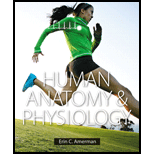
Concept explainers
Sequence the following list of events of a neuronal action potential by placing 1 next to the first event, 2 next to the second event, and so on.
a. _______ The activation gates of voltage-gated
b. _______
c. ________ Local potentials depolarize the membrane to threshold.
d. ________ The inactivation gates of voltage-gated
e. ________ Repolarization continues and Na+ channels return to resting.
Want to see the full answer?
Check out a sample textbook solution
Chapter 11 Solutions
Human Anatomy & Physiology
- Assume presynaptic excitatory neuron A terminates on a postsynaptic cell near the axon hillock and presynaptic excitatory neuron B terminates on the same postsynaptic cell on a dendrite located on the side of the cell body opposite the axon hillock. Explain why rapid firing of presynaptic neuron A could bring the postsynaptic neuron to threshold through temporal summation, thus initiating an action potential, whereas firing of presynaptic neuron B at the same frequency and the same magnitude of EPSPs may not bring the postsynaptic neuron to threshold.arrow_forwardAnswer the following questions regarding conduction of action potentials using the velocities given on p. 100: a. How long would it take for an action potential to travel 0.6 m along the axon of an unmyelinated neuron of the digestive tract? b. How long would it take for an action potential to travel the same distance along the axon of a large myelinated neuron innervating a skeletal muscle? c. Suppose there were two synapses in a 0.6 m nerve tract and the delay at each synapse is 1 msec. How long would it take an action potential and chemical signal to travel the 0.6 m now, for both the myelinated and unmyelinated neurons? d. What if there were five synapses?arrow_forwardImagine that a toxin creates pores that are permeable to Ca2+. Describe its immediate effect on the resting potential of the neuron: identify which ions diffuse across the membrane, which direction they diffuse (and why), and whether this brings the neuron closer to or further from threshold potential. asap pleasearrow_forward
- There is a type of toxin found in the liver of the puffer fish that prevents the opening of voltage-gated Na+ channels in neurons. The effect of this toxin is to: Group of answer choices A. prevents the initiation of the action potential B. depolarizes the membrane potential and maintains it depolarized C. prolongs the return of the membrane potential to the resting level D. increases the duration of the action potentialarrow_forwardWhy does neuronal function require the voltage-gated K+ channels to open moreslowly than the voltage-gated Na+ channels and how would you expect the voltage-gated K+ channels to affect the shape of an action potential curve?arrow_forwardIn an experiment, the extracellular [Na+] surrounding a nerve cell was reduced from 145 to 45 mM. Which of the following is the most likely effect of this on action potentials? No action potentials would occur because the concentration of extracellular Na+ is too low. The membrane potential would become more negative so the threshold for action potential generation could not be reached. The nerve cell would still produce an action potential but its amplitude would be reduced and the depolarisation phase would be slower. The nerve cell would still produce an action potential but its amplitude would be reduced and the depolarization phase would be more rapid.arrow_forward
- Which of the following statements is TRUE of the action potential? A. At the peak of the action potential there are approximately an equal amount of open voltage gated sodium and potassium channels B. To reach threshold the action potential requires the activity of sodium potassium pump C. During the rising phase (prior to the peak) of the action potential more voltage gated sodium channels are open than voltage gated potassium channels D. None of the choice options are TRUE of the action potential E. The overshoot phase (below resting membrane potential) is a result of voltage gated sodium channels taking a long time to close.arrow_forwarda.Would an action potential travels faster in an axon with a wide diameter or a small diameter? b. Would an action potential travel faster in an axon that is myelinated or unmyelinated?arrow_forwardDendrotoxins, produced by the mamba snakes (Dendroaspis), are inhibitors of the voltage-gated K+ channels. What phase of the action potential would this toxin affect? How would it affect ion permeability during this phase? How would ion movement be affected?arrow_forward
- In Japan, the consumption of “Fugu” (a kind of sashimi sushi) is considered to be a “manly” act. The danger associated with consuming Fugu is due to the presence of tetrodotoxin, a potent neurotoxin found in various organs of the pufferfish. a. If the Fugu toxin on a neuron “driving” toward Ex of most permeable ion, is an action potential more or less likely under these conditions? b.Which (flaccid or tonic) is the result in this case? What would be the associated physical symptoms of this condition?arrow_forwardNerve membrane hyperpolarization after an action potential a)Is the movement of membrane potential voltage below normal resting potential voltage. b) This Is mostly due to the slow-closing of K+ channels. c)Makes it more difficult to evoke another action potential. d) This Is mostly due to the slow-closing of Na+ channels.arrow_forwardWhat membrane protein of the neuron is responsible for briefly increasing the Na+ permeability of the membrane during the rising phase of the nerve impulse? a. the sodium-potassium pump b. the voltage gated potassium channel c. the voltage gated sodium channel d. the stimulus gated sodium channel e. the ligand gated ion channelarrow_forward
 Human Physiology: From Cells to Systems (MindTap ...BiologyISBN:9781285866932Author:Lauralee SherwoodPublisher:Cengage Learning
Human Physiology: From Cells to Systems (MindTap ...BiologyISBN:9781285866932Author:Lauralee SherwoodPublisher:Cengage Learning
